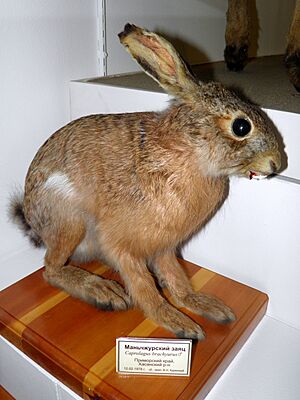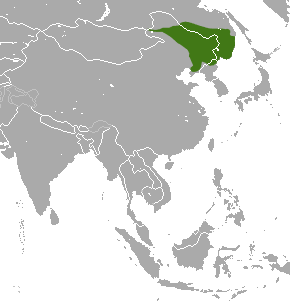Manchurian hare facts for kids
Quick facts for kids Manchurian hare |
|
|---|---|
 |
|
| Conservation status | |
| Scientific classification | |
| Genus: |
Lepus
|
| Species: |
mandshuricus
|
 |
|
| Manchurian hare range | |
| Synonyms | |
|
|
The Manchurian hare (Lepus mandshuricus) is a type of hare that lives in the forests of northeastern China and Russia. You can also find them in the Amur River area and the tall mountains of northern North Korea. These hares prefer living in woodlands. Experts say their conservation status is "least concern", which means they are not currently in danger of disappearing.
What Does the Manchurian Hare Look Like?
An adult Manchurian hare usually weighs about 2 kilograms, which is like two bags of sugar. Its body is about 40 to 48 centimeters long. That's roughly the length of a school ruler. They also have a small tail, measuring about 4.5 to 7.5 centimeters.
Their ears are typically 7.5 to 10.4 centimeters long. Compared to the Korean hare, the Manchurian hare has shorter back legs and smaller ears. Sometimes, you might see a very dark or black Manchurian hare. This is a natural color variation.
Where Do Manchurian Hares Live?
The Manchurian hare makes its home in eastern Russia and northeastern China. Their territory stretches from the Ussuri River region in Russia. It goes through Chinese areas like Heilongjiang, Jilin, Liaoning, and Inner Mongolia. They might even live as far south as North Korea. In North Korea, their home range could overlap with the Korean hare.
These hares love living in forests. They especially like mixed woodlands, which have both leafy and needle-leaf trees. They tend to stay away from open fields and places where people live. You can find them in forests up to about 900 meters high.
Manchurian Hare Conservation
The Manchurian hare lives across a large area. It can be found in several protected nature reserves. The main challenge for these hares is that their forest homes are changing or being lost. This allows another type of hare, the tolai hare, to spread. Tolai hares have many babies and are very good at competing for food and space. The Manchurian hare struggles to compete with them.
We don't know exactly how many Manchurian hares there are right now. We also don't know if their numbers are growing or shrinking. However, the International Union for Conservation of Nature has listed them as a species of "least concern." This means they are not currently considered to be at risk of extinction.


